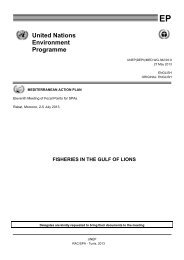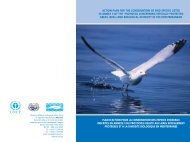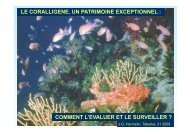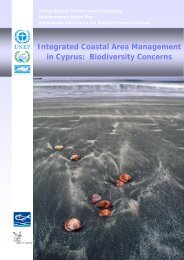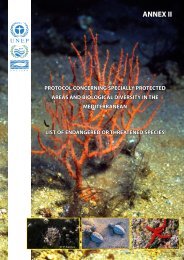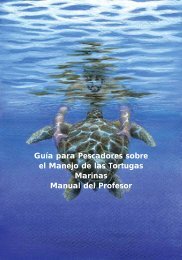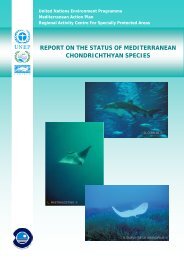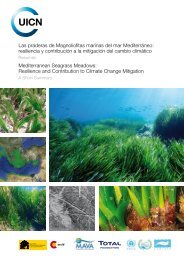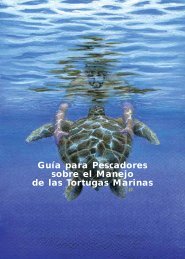Proceedings of the Second Mediterranean Symposium on Marine
Proceedings of the Second Mediterranean Symposium on Marine
Proceedings of the Second Mediterranean Symposium on Marine
Create successful ePaper yourself
Turn your PDF publications into a flip-book with our unique Google optimized e-Paper software.
At <str<strong>on</strong>g>the</str<strong>on</strong>g> end <str<strong>on</strong>g>of</str<strong>on</strong>g> <str<strong>on</strong>g>the</str<strong>on</strong>g> summer 1999, an unprecedented mass mortality <str<strong>on</strong>g>of</str<strong>on</strong>g> benthic<br />
invertebrates (mainly gorg<strong>on</strong>ians, sp<strong>on</strong>ges, ascidians and bryozoans) occurred al<strong>on</strong>g <str<strong>on</strong>g>the</str<strong>on</strong>g><br />
coasts <str<strong>on</strong>g>of</str<strong>on</strong>g> Provence (France), French Riviera and Ligury (Italy). Excepti<strong>on</strong>ally high<br />
temperatures throughout <str<strong>on</strong>g>the</str<strong>on</strong>g> water column (23-24°C) for over <strong>on</strong>e m<strong>on</strong>th, down to<br />
40 m depth, could have created an envir<strong>on</strong>mental c<strong>on</strong>text favourable to <str<strong>on</strong>g>the</str<strong>on</strong>g> mass<br />
mortality event (Cerrano et al., 2000; Coma et al., 2000; Pérez et al., 2000; Romano et<br />
al., 2000). This episode is <str<strong>on</strong>g>of</str<strong>on</strong>g> particular interest since, should <str<strong>on</strong>g>the</str<strong>on</strong>g> present day warming<br />
trend c<strong>on</strong>tinue, it could be <str<strong>on</strong>g>the</str<strong>on</strong>g> harbinger <str<strong>on</strong>g>of</str<strong>on</strong>g> even more drastic events.<br />
Unfortunately, as far as macrophytes are c<strong>on</strong>cerned, very little informati<strong>on</strong> is available<br />
about <str<strong>on</strong>g>the</str<strong>on</strong>g> possible effect <str<strong>on</strong>g>of</str<strong>on</strong>g> <str<strong>on</strong>g>the</str<strong>on</strong>g> warming up <str<strong>on</strong>g>of</str<strong>on</strong>g> <str<strong>on</strong>g>the</str<strong>on</strong>g> <str<strong>on</strong>g>Mediterranean</str<strong>on</strong>g> water: (i) Some<br />
encrusting corallines (Rhodobi<strong>on</strong>ta, Plantae) were said to have been affected by <str<strong>on</strong>g>the</str<strong>on</strong>g><br />
1999 summer warm episode (Cerrano et al., 2000), but nothing is known about <str<strong>on</strong>g>the</str<strong>on</strong>g><br />
extent <str<strong>on</strong>g>of</str<strong>on</strong>g> <str<strong>on</strong>g>the</str<strong>on</strong>g> phenomen<strong>on</strong> and <str<strong>on</strong>g>the</str<strong>on</strong>g> subsequent recovery. (ii) The native Caulerpa<br />
prolifera (Chlorobi<strong>on</strong>ta, Plantae) is extending its range area northwards, from Corsica, <str<strong>on</strong>g>the</str<strong>on</strong>g><br />
Tyrrhenian Sea and <str<strong>on</strong>g>the</str<strong>on</strong>g> French Riviera to Ligury and Provence (Bianchi and Morri, 1994<br />
and unpublished data). Outside <str<strong>on</strong>g>the</str<strong>on</strong>g> <str<strong>on</strong>g>Mediterranean</str<strong>on</strong>g>, in <str<strong>on</strong>g>the</str<strong>on</strong>g> Gulf <str<strong>on</strong>g>of</str<strong>on</strong>g> Maine (USA), a<br />
synergy between climate change and introduced species has been observed (Harris and<br />
Tyrrell, 2001).<br />
A CASE STUDY: THE DECLINE OF CYSTOSEIRA FORESTS<br />
More than 50 taxa bel<strong>on</strong>ging to <str<strong>on</strong>g>the</str<strong>on</strong>g> genus Cystoseira (Fucophyceae, Chromobi<strong>on</strong>ta,<br />
Stramenopiles) thrive in <str<strong>on</strong>g>the</str<strong>on</strong>g> <str<strong>on</strong>g>Mediterranean</str<strong>on</strong>g> Sea (Ribera et al., 1992). Most <str<strong>on</strong>g>of</str<strong>on</strong>g> <str<strong>on</strong>g>the</str<strong>on</strong>g>m are keyspecies<br />
in a variety <str<strong>on</strong>g>of</str<strong>on</strong>g> forest communities which are encountered <strong>on</strong> subtidal and<br />
circalittoral hard bott-oms (Giacc<strong>on</strong>e and Bruni, 1972-1973). In additi<strong>on</strong>, <str<strong>on</strong>g>the</str<strong>on</strong>g>y are usually K<br />
strategists and l<strong>on</strong>g-lived (at least 45 years for C. spinosa; Ballesteros et al., 1995, 1998).<br />
Since <str<strong>on</strong>g>the</str<strong>on</strong>g> 1960s, Cystoseira forests have underg<strong>on</strong>e a severe decline in extensive areas<br />
<str<strong>on</strong>g>of</str<strong>on</strong>g> <str<strong>on</strong>g>the</str<strong>on</strong>g> <str<strong>on</strong>g>Mediterranean</str<strong>on</strong>g>. Several species <str<strong>on</strong>g>of</str<strong>on</strong>g> Cystoseira and <str<strong>on</strong>g>the</str<strong>on</strong>g> communities <str<strong>on</strong>g>the</str<strong>on</strong>g>y dominate<br />
are c<strong>on</strong>sidered as threatened (Boudouresque et al., 1990). The decline <str<strong>on</strong>g>of</str<strong>on</strong>g> C.<br />
amentacea, which thrives in <str<strong>on</strong>g>the</str<strong>on</strong>g> subtidal fringe under str<strong>on</strong>g surf exposure, has been<br />
related to polluti<strong>on</strong> (Bellan-Santini, 1966). The regressi<strong>on</strong> <str<strong>on</strong>g>of</str<strong>on</strong>g> deeper Cystoseira forests<br />
(e.g. C. brachycarpa, C. spinosa and C. zosteroides) may be due to a cascade effect<br />
(sensu Steneck, 1998), though o<str<strong>on</strong>g>the</str<strong>on</strong>g>r causes may be involved (Sala et al., 1998): overfishing<br />
<str<strong>on</strong>g>of</str<strong>on</strong>g> sea-urchin predator fish (e.g. Sparus aurata) leads to a surge in numbers <str<strong>on</strong>g>of</str<strong>on</strong>g><br />
<str<strong>on</strong>g>the</str<strong>on</strong>g> browser Paracentrotus lividus, which in turn overgrazes benthic macrophytes,<br />
especially palatable and str<strong>on</strong>gly preferred (Verlaque and Nédélec, 1983; Lemée et al.,<br />
1996) Cystoseira species, which results in "barren grounds" with <strong>on</strong>ly encrusting<br />
corallines, ephemeral macrophytes and sea-urchins (Verlaque, 1987a; Sala et al., 1998;<br />
Boudouresque and Verlaque, 2001). O<str<strong>on</strong>g>the</str<strong>on</strong>g>r causes <str<strong>on</strong>g>of</str<strong>on</strong>g> more local significance can be put<br />
forward to explain <str<strong>on</strong>g>the</str<strong>on</strong>g> Cystoseira forest's decline, e.g. turbidity (which diminishes<br />
irradiance and <str<strong>on</strong>g>the</str<strong>on</strong>g>refore <str<strong>on</strong>g>the</str<strong>on</strong>g> compensati<strong>on</strong> depth), silting, gill nets and trawling.<br />
ACTES DU DEUXIEME SYMPOSIUM MEDITERRANEEN SUR LA VEGETATION MARINE (ATHENES, 12-13 DECEMBRE 2003)<br />
47




